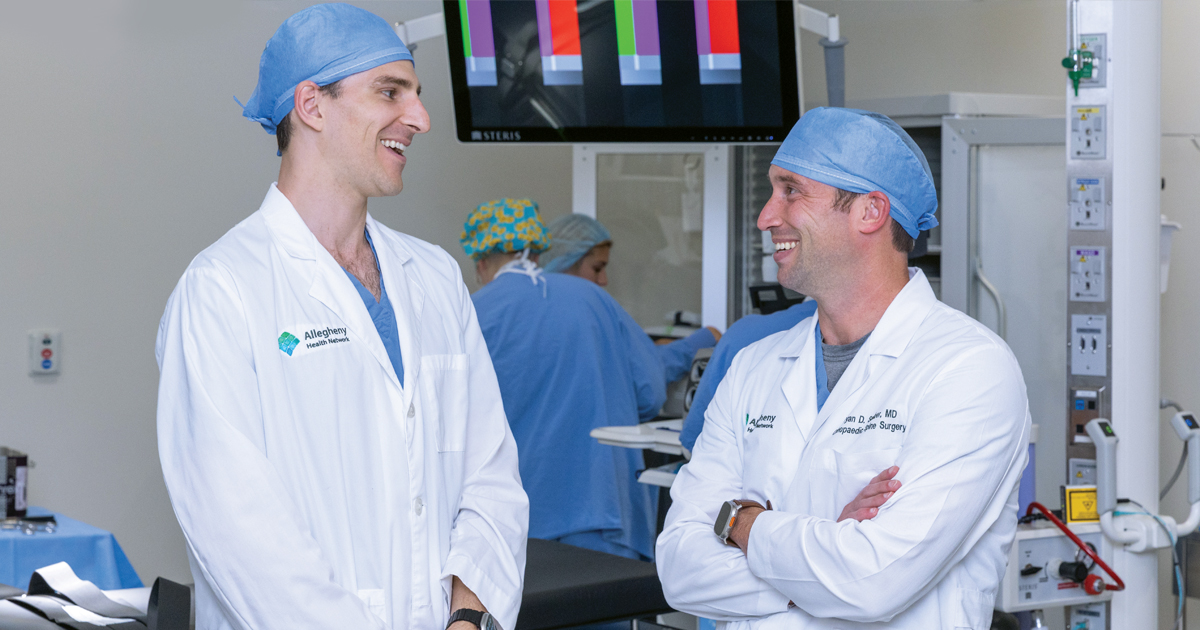Finding Pain Relief with Minimally Invasive Spine Surgery

Back pain can make daily life harder and affect your mood, energy, and ability to do the things you love.
About 80% of people in the U.S. will have back pain at some point in their lives.* For many, this pain can be a sign of a more serious spinal issue. AHN Wexford Hospital offers a solution: minimally invasive spine surgery.
What is minimally invasive spine surgery?
Minimally invasive spine surgery uses small incisions (cuts) to fix spine problems, while not disrupting nearby muscles and tissues. The goal is to get you back to a pain-free life as quickly and safely as possible.
There are different types of minimally invasive spine surgery, including:
- Tubular surgery – A technique using a round tube to create a tunnel to the spine and pass tools through the tunnel to adjust spinal tissue.
- Endoscopic spine surgery – A procedure where an endoscope (long, thin tube) with a camera on the end is placed inside the body to evaluate and treat spinal issues.
- Minimally invasive spinal fusion – This involves joining two spinal bones together to reduce pain and movement problems.
- Laminectomy – Removing a small piece of bone to give nerves in the spine more room and reduce nerve pressure.
With minimally invasive surgeries, many people go home the same day as their procedure and recover faster than with traditional surgery.
AHN Wexford Hospital has some of the best tools available for these procedures, like motion preservation tools and robot-guided technologies. Your surgery team will help you decide what method makes the most sense for you based on your symptoms and health.
Reasons for surgery
The discs in our spine are like bouncy cushions; they’re designed to support us as we bend and move. Over time, these discs can stiffen, dry out, or stop working properly. Factors like aging, injuries, smoking, or extra weight can increase the risk of spine problems.
Common conditions that may need surgery include:
- Spinal stenosis – A narrowed spinal column that puts pressure on the spinal cord.
- Herniated disc (also referred to as a slipped or bulging disc) – This occurs when the soft center of a spinal disc bulges out from its outer ring.
- Sciatica – Pain from a pinched sciatic nerve that runs down the lower back and legs, often from a slipped disc.
- Degenerative disc disease – Weakening of spinal discs over time, often linked to aging or genetics.
- Spondylolisthesis – When two spinal bones are not properly aligned.
Lifestyle adjustments for spine health
Some spinal health factors are out of your control, but there are things you can do to promote back pain relief and keep your spine as healthy as possible leading up to your surgery.
These include:
- Moving your body regularly and consistently
- Losing weight, or maintaining a healthy weight
- Improving your posture
Your AHN doctor can suggest ways to adjust your lifestyle and daily habits for better spine health and to support recovery.
Take the next step
Learning about spine surgeries is an important step in advocating for yourself and your spinal health. Schedule an appointment at Wexford Hospital today to explore the best option for you and your pain relief.
Source: Low Back Pain. https://www.ncbi.nlm.nih.gov
About Benjamin B Whiting, MD
Benjamin Whiting, MD, is a neurosurgeon with the AHN Neuroscience Institute specializing in complex spine surgery. Dr. Whiting has expertise in anterior and lateral lumbar spinal surgery and is skilled in managing cervical and lumbar motion preservation, brain trauma, spine trauma, and adult cervical deformity.
Neurologists at Wexford Hospital expertly treat a wide variety of conditions from headaches to brain tumors with the most advanced treatments available.

